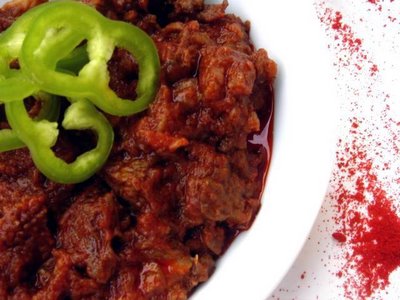 Bocsánat, ez most nincs magyarul, mert lusta vagyok…de csak sima pörkölt recept a külföldieknek.
Bocsánat, ez most nincs magyarul, mert lusta vagyok…de csak sima pörkölt recept a külföldieknek.Well, originaly, I thought, the only recipe I wouldn’t post about on this site would be the one of a Hungarian goulash. However, then I looked around a bit on internet (before, of course I was never looking for a goulash recipe, since it’s something I’ve cooked thousend times..), have discovered a lot of different recipes with the title of an „authentic Hungarian goulash recipe” and seeing those, I told myself, oh yes, post it! And my parcel sent in the framework of the EBPP (help, where is it, it should have arrived already and no signs yet….) also contains a few ingredients and maybe my adressee is willing to try it. So without any further much ado and without going into poetry about the history of the Hungarian cuisine – which I shall do another time but I’m so lazy for right now.. (but here I found a good article if you are interested –although the author seem to have a Polish name, but still..), here we go:Let’s start with some quick terminology: there might be some confusion about what exactly is called a goulash (although I think maybe only English speaking Hungarians may have created this confusion because for everyone else it seems to be obvious that it’s that thick meat stew.) But in theory it could cover the following Hungarian dishes:
PÖRKÖLT – a slowly cooked thick meat stew (it looks like on the picture above) which can be made of all kinds of meat: beef, chicken, pork or even fish. I consider this one as the typical Hungarian stew that is translated as a goulash in other languages. My recipe goes for this. It’s served normally with bite size dumplings (galuska), or boiled potatoes (or even sometimes with plain pasta in school or company cantines )
GULYÁSLEVES – goulash soup- you see, this one at least really contains the word goulash. This is indeed a liquid soup – the preparation starts exactly the same way as of a stew but then more water is added, plus vegetables (a few carrots, parnsnips and a lot of cubed potatoes). In terms of spices, it contains caraway seeds. So, it has really a soup consistancy and is eaten with some good fresh bread. This one is made of beef only.
PAPRIKÁS – this one is mainly known as the famous chicken paprikash. It is mostly made of -well, chicken, but it’s also common to prepare it with veal or also fish (such as freshwater catfish). The base is absolutely the same as with pörkölt but then a bit more water is added and at the very end of the cooking the sauce is thickened with the addition of sour cream and flour. So it has more sauce on it as pörkölt. This one is always served with dumplings.
(Ok, and finally we also have something which is really called GULYÁS – as it is-it would be a dish somewhere between a pörkölt and a gulyás soup – it would be thicker then a soup and contain potatoes. This would be mainly cooked outdoor in a big cast-iron kettle (bogrács) and most of the time a good amount of red wine would also be added. This is often prepared during folkloristic events for tourists, sometimes at outdoor parties but very rarely in home-cooking.
And by the way, all above (well, at least the three first ones) are dishes which are cooked and eaten in everyday life in Hungary, so those are not touristy dishes offered only on restaurant menus for foreigners but something which families prepare and eat very often.
Now, to the recipe. Of course, you can imagine, there are as many different goulash recipes as cooks. So, this is how we prepare it in my family and I would consider is as a basic recipe for a pörkölt. I think it’s really easy to cook it and you just absolutely can’t go wrong if you follow a few basic rules.
There a two SECRETS of a good goulash: the ingredients you add to it and the ones you don’t. In my opinion the secret ingredient of a perfect Hungarian stew (besides a good quality Hungarian paprika of course) is onion. A lot. More. A lot more!! For 1 kg meat (two pounds) I would use about 3-4 big onions. That seem to be a lot but this will create your thick sauce. As you’re simmering the stew on very low heat for about 1,5 hours, the onions melt into a sweet, spicy sauce, so you won’t have any pieces of it at the end.
What you never ever would add to a pörkölt are any of the following ones: flour, butter, canned tomatoes (all three I see in many „authentic” recipes). There are a few optional ingredients that could be added, this really depends on your taste, on habits and on what you have on hand. (e.g. pork fat instead of oil, smoked bacon, green pepper, fresh tomato, red wine, caraway seeds)
Recipe (4 servings):
1 kg beef for stews, cubed
3-4 big onions, finely chopped
4-5 tbsp groundnut oil
3-4 tbsp best quality Hungarian sweet paprika
salt, pepper
1 green pepper, sliced (the kind which is on the picture, not bell peppers)
1 fresh tomato (this one I add only if I’m in Hungary or if I can get some really tasty good quality tomato, otherwise it just makes the sauce too watery and sour and doesn’t add anything to the flavour)
Heat oil in a saucepan. Add the finely chopped onions and cook until translucent. Now comes an important secret step: remove the saucepan from the heat and now add the paprika – this is very important as if you would do this step still on the heat, the paprika could burn from the sudden heat and get bitter. Put it back, add beef cubes and stir so that the spicy onion mix covers th meat evenly. Cover with about 100-150ml water so that the liquid doesn’t completely cover the meat. Add the sliced green pepper, the whole tomato (later will be removed at the end), salt, pepper. Simmer covered on very low heat for about 1-1,5 hours. After 1 hour, check, add a litle more water if necessary, so the stew doesn’t burn. Depending on the thickness of the sauce, cook for 10-15 minutes uncovered so that all the liquid reduces and all what you get is a spicy, thick sauce which covers the meat. It tastes even better reheated, I normally prepare it a day ahead.
ISO50
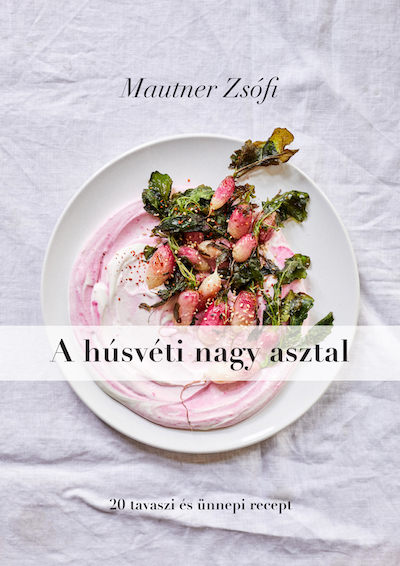
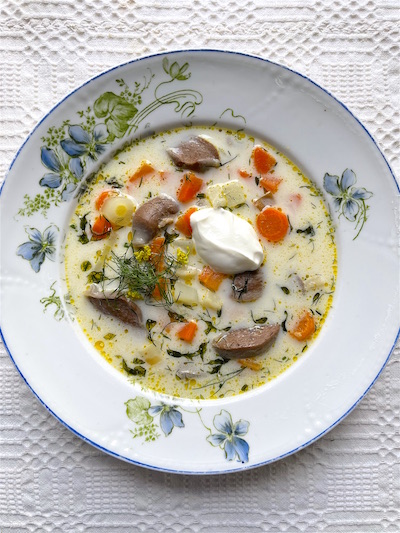
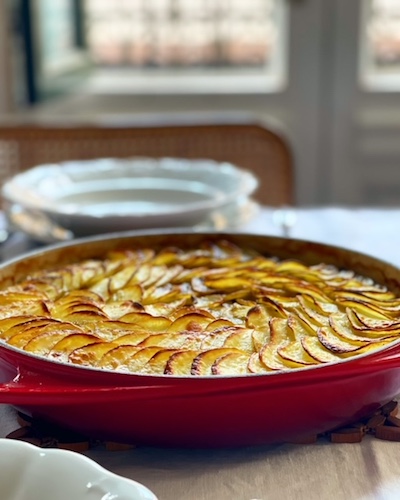


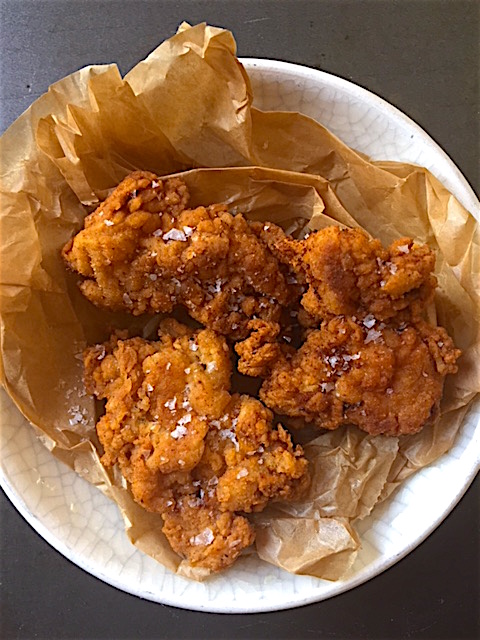

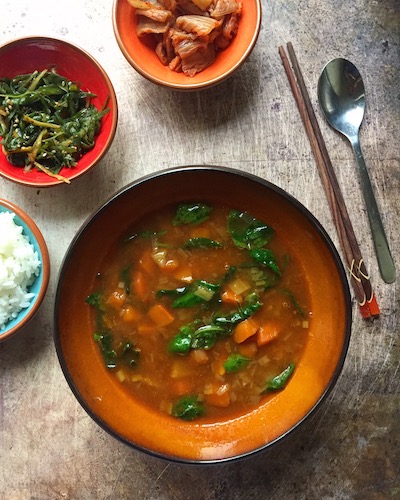

Thank you, Zsofi, for this highly intersting post. It think even in a world of „fusion” cuisine it`s good to know what is really AUTHENTIC. As you say I have seen so many goulash recipes in the web which make me shiver ;-( – but though we also consider „Gulasch” as a part of the „Austrian” (but we mean Austrian-Hungarian) food heritage your writing brings along a lot of helpful information to me, especially regarding terminology. What we have here in Austria is „Rindsgulasch” (beef goulash), but it never (or rarely) contains any green peppers or a tomato. Until reading your post I believed it would be an absolute no-no to add a tomato, I thought that’s a really unauthentic thing to do, how interesting to read that I was wrong. Then we have the „Gulaschsuppe” (goulash soup) which you can order in every coffehouse, it is just as described by you. And thus our famous „Kalbsgulasch” (veal goulash, with sour cream added to it) is supposed to be a paprikas (we also know a chicken version of it). Of course there are some more fancy versions, for example served with fried eggs, cornichons etc. etc. („Herrengulasch” for example), and according to your touristic version there is „Erdäpfelgulasch” (potatoe goulash), which is a simple and cheap everyday’s life food, made with lots of potatoes and very often sausage instead of meat. So now the confusion is complete, I presume 😉 Thank you for writing such posts worth reading, many hugs from Vienna to Brussels (via Budapest !), angelika
angelika has said it all already – i love goulash myself and couldn’t do without goulash soup as a midnight feast at parties either… brings your stomach back into shape after a night’s drinking!vienna even has a restaurant that specialises in goulash: the gulasch museum – it has goulash (or rather porkolt, as you say) in every form imaginable and they’re all delicious. My favourite, though, is a fiakergulasch, served with a frankfurter sausage and gherkins – and potatoes to accompany it! yumm!
oh, and i forgot to say: the paprika i use is authentic hungarian paprika. my dad’s colleegues mum still lives there and grows, smokes and grinds her own. When they came over to visit a few years ago, they sent me enough to last a lifetime… a jar of sweet and a (smaller) jar of hot paprika, and boy! is it hot!!! but it’s amazing just how much better it tastes than what we can buy in the supermarkets!
Thanks for a informative and interesting post as well. to add to the confusion – what we call ‘guljašš’ in Estonian is a thick meat stew that we serve with boiled potatoes usually (and it’s VERY popular), although most (well, many) Estonians are aware that in Hungary a guljašš is more soupy than stewy. So our guljašš is actually pörkölt:) I will be cooking goulash a la Chili&Vanilia soon, for sure (and yes, I will concentrate:)
great post, and let a 1000 flowers bloom, although I would like to raise some issues regarding different ‘schools’ of cooking in Hungary.first: the onion stuff. I’d definitely add only the _half_ amount of onion for this amount of meat. onion _could_ end up in a thick sauce if you prepare it well, but it definitely will make the whole thing a lot sweeter. purist would say use as little onion as possible.second: caraway seeds in goulash. maybe, never seen.third: groundnut oil. come on, if you don’t use pork fat, use at least sunflower oil. this is a bit new cuisine for me. purist again go for animal fat in case of a pörkölt, paprikás or gulyás.on the other hand I would say that the only English language cookbook that I’ve found to be correct on Hungarian couisine is Culinaria Hungary from Könemann
Hallo Österreich, hello Estonia, hahó Magyarország!Oh, I was expecting some discussion about this..Now I think people are even more confused:)A few reactions:peppers,tomatoes – I add those for the flavour, but strictly only if I have good ones. Bell peppers and supermarket tomatoes are totally out of question.The onion stuff:I really cook it with that amount, OK, let’s say,I’m not the purist,but I LOOVE to dip some fresh white bread into that thick sweet sauce..hmmmmPork fat thing: oh yeaah, I was jut too embarassed to wright that down, OK?:)And finally, I absolutely agree with your comment on the Könemann book, it’s the only one I would ever recommend to anyeone seriously interested in the Hungarian cuisine.Thank you everyone for your comments!!
no azért mán’ nadeZsófi!1. azt még elviselem, hogy csokiszagoló helyett vaníliaszagolókról kell olvasgatnom alant. rendben, végülis csokimussz vagy vaníliamussz – végs esetben csereszabatos….2. azt is, hogy kóstolgatsz a sültcéklával, habár azért az sok köménnyel, a vörösboros marhapörkölt mellé az igazi….3. nadehogy an undoubtedly knowledgeable Austrian girl tries to „Monarhise” THE Hungarian food, it’s a bit of an offense, I can only compromise IF we can agree that Sacher-torte mit Schlagober is Hungarian :))) Deal?????
hi gergo, you might not be referring to me, but to angelika, but you are absolutely right: austria has a history of blatantly stealing other nations’ recipes and then claiming them to be their own (to their/our defense I might add that probably not consciously, just because it’s become as natural to them as pizza has to the Italians… I realise I’ve just opened another can of worms here ;-)) it’s the same with wiener schnitzel (apparently originating in milan), the strudels and other sweet pastry coming to us from bohemia and hungary… we just can’t help it – we love it so much it must be ours!
now the following is only in Hungarian, but it’s titled ‘the most delicious pörkölts of the world’http://www.szeptemberfeszt.hu/2000/recept.html
Well, „caraway seeds in goulash. maybe, never seen” – you should pay us a visit 🙂 ‘ALWAYS put cs in your goulash,’ my great-grandma told me (she’s from the southwestern part of Hu). And loads of onion, too (about 2 big ones for a pound of meat). Agree with the pork fat thing though.
Gergő,ne szítsd itt má nekem az indulatokat:)))inkább lesz csoki,ígérem:)soobrosa, köszi a site-ot, ígérem, ha lekgözelebb 900kg szilaj szürkemarhahúsra teszek szert, ezt próbálom ki:)
Caraway seeds is used for porkolt, goulasch soup, and a paprikas. Or make it correct: in my familly:) My father heat the oil, the put a tsp of caraway seed into the hot oil. But as chili & vanilia wrote:) as many recepie as many cook:) Horasz
I’m hesitating leaving a comment as I wrote a post on Gulyasleves and I’ve been nowhere near Hungary! My source was indicating that gulyas refered to the soup version, so if there is a mistake there could you let me know. The post is at http://tankeduptaco.blogspot.com/2006/02/memories-of-easter.html
Hi Zsofi,Thank you so much for this great recipe. I’ll have to try it next time I make goulash. Now I know how to leave out the flour and still get the sauce to thicken — a TON of onions 🙂 Cheers,-Helen
Ezt a megjegyzést eltávolította a blog adminisztrátora.
Thankyou Chili & VanillaGreat post – well said! I too am Hungarian – and my mom and I just recently co-authored a cookbook. They are her secret recipes and needed to be penned. Many of her friends have alzheimers and I feared her forgetting even the simplest cohlrabbi soup recipe. So – for her 80th birthday, we presented guests and family with our gift – and sales have soured since.My point – which I am trying to make is that in the journey, I found out about all these great hints and secrets and lovely little added touches. Bogracs Gulyas – the only kind. I too found out about paprikas and porkolt -being different but the same – if you will!Authentic – I don’t think anyone has the corner on That one! I think it’s more of a „variation on a theme” – like a great Rhapsody – in music is a one-movement work that is episodic yet integrated, free-flowing in structure, featuring a range of highly contrasted moods, color and tonality. An air of spontaneous inspiration and a sense of improvisation make it freer in form than a set of variations. I think we should call it Rhapsody of Gulyas!Cia – Klara Czegeny
I’ve always associated garlic with Eastern Europe, because of the vampire legends. Then why no garlic in these recipes? Do they eat garlic at all in Hungary, or is it used only to ward off vampires? And why no pepper (the hot spicy kind, cayenne or black) as well? You speak of a ton of onions as being „spicy”, but neglect to put in any pepper. I find this very curious.
Ez egy őrült klassz blog. Ennyire eddig még egyedül csak a Váncsa írásai kötöttek le, senki és semmi más (na jó, a Káma Szútra :))). Gratulálok!!! De egy apróság: gulyáshoz olaj????!!!
Very tasty recipe! And extremely easy to make.Though I’m a little mystified as to what to do with the tomato in the recipe, if using one.
i read the story about the cousin of rigo jancsi in hungarian ( a bit rusty these days) but whereas the first half of the story was amusing, the second half was pure tragedy. no one who has seen any part of the holocaust can claim that it was amusing! 11 million people were exterminated. i have only spent one month in a concentration camp, but it is seared in my memory.
Hali!Ez nem gulyás recept, hanem pörkölt, és nem autentikus. Pörköltnek fura, mert mi itt Magyarországon nem használunk „groundnut oil”-t semmiképpen sem a pörkölt készítéséhez. Nyugodtan írhattad volna a sertészsírt, nem szégyen.
Szia, szerintem pedig teljesen autentikus. És tényleg nem gulyás, hanem pörkölt, ez a részletes terminológiai leírásból, asszem elég jól kiderül:)ez az írás pedig külföldieknek készült,nekik pedig a goulash a pörkölt
Hi. My optional ingredients: bacon (kolozsvári) and HOT green pepper (some like it hot). Szia, Zsuzsi
The famous Hungarian gulash was originally a soup, but plenty of meats, potatoes and little noodles(csipetke), it can be eaten as a main course.
This is a recipe for a pörkölt, not a gulyás…Since you went through the trouble of explaining the terminology, you shouldn’t need to repeat the same linguistic mistake that is so prevalent! Besides the nut oil, looks like a great recipe!
Dear Anonymus, if you repeat it again and again, in Hungarian or English, the title still won’t be changed, I’m sorry. I absolutely don’t consider it as a linguistic mistake for the reasons mentioned earlier.
Everytime I come to your site I poor over the pictures and stare at the text hoping that my brain will decipher the code. I didn’t notice the „English” posts until today. Yipppeeeee!!!I love this recipe and I’m excited to try out your authentic Hungarian food. A long time ago when I was acting in London, we did a Hungarian play. To get into our roles the director had us make Hungarian food everyday so we could understand the flavors of the country. I really liked the paprika chicken. Do you have a recipe for that one? Hopefully I’ll get to come visit one of these days.Bisous, Ms. Glaze
Nice to see the world is getting the word out about this terrific cuisine! I’ve recently been inspired to start a blog on the topic (Hungarian food).< HREF="http://hungarianfoodrecipes.blogspot.com/" REL="nofollow">Hungarian Food Recipes<>
No Hungarian has ever made a goulash with groundnut oil. It is so stupid.We use pig fat instead.
this is not a goulash, this is rather a pörköltand nut oil is impossible to find in Hungary. funny.
If you only use fresh tomatoes, does this mean that you only make this dish in the summer when tomatoes are in season?
Dear Elise, sorry for the late response. No, it just means that I only add a fresh tomato if I find a good one. In the winter (or here in Brussels)I simply don’t add any tomatoes ,just peppers.
I am of Hungarian descent and have had dozens of types of goulash (my favourite food), cooked in kitchens all around the world.In my humble opinion, although I have rarely met a goulash I did not like, there are some sacrosanct ingredients for the BEST goulash.These are: real Hungarian paprika, lard, caraway seeds, green pepper, and little flour dumplings.To anyone trying out the various recipes here and elsewhere, make sure you try your recipe with the above. You may just find your definitive flavour of goulash!Just another note: porkolt and paprikas may be close to goulash and be very similar in the making, but any Hungarian can tell instantly and without question which is the food they have been served. It is all in the spices and ingredients. In fact, I was astounded by the assertion that goulash is close to, or like, those others. In my mind there is a world of difference. So make a goulash a goulash and not a ‘sort of’ goulash. Then make porkolt and then make paprikas. Each are delicious. Explore the differences and the tastes. It is well worth it!Cheers!
Hello:Thanks for the recipe, the porkolt is simmering in the kitchen, and reminds me of my Nagymama’s house in Bekes. My parents left Hungary and settled in Brussels for a short while, before they moved on to Canada-I hope to visit someday, maybe look up some distant relatives! Anyway, my Hungarian not being what it once was, I was hoping that you might have the following recipes in English: szilvas gomboc, meggyes retes, and meggy leves – I love these dishes, but the English language recipe books I have so far just don’t do them justice. I checked out the book that was recommended, by Konemann, and I think I’ll get it on line – so thanks for that! Well, I think the porkolt is ready – dinner time!Anita
Hi Anita, hope your porkolt turned out great! sure, if you drop me an e-mail, I’m happy to send you the recipes for szilvás gombóc and meggyleves!
I made this a while back, but i made is spicy by using hot and regular paprika that i got from my best friend that is Hungarian, anyways, we mixed it with sour cream and it was REALLY good. This recipes is also REALLY EASY!. Thank you
Good Job! 🙂
Egy másik pörkölt recept ->http://kulvaros.blogspot.com/LOL
http://kulvaros.blogspot.com/
well done!finally somebody did explain this whole story!vegre valaki nem volt lusta(mint en)leiirni ezt az egeszet,hatha a kulfoldiek megertik mostmar.en londonban elek es dolgozok,es abban az etteremben ahol felszolgalok minden kedden a specialitas az”Hungarian Goulash”vagyis marha porkolt ami ugyan nagyon finom(foleg miota EN szerzem be a szegedi paprikat nekik)amikor felrakta a fonokseg a menure akkor megkerdeztek hogy mit szolok hozza,amire en azt mondtam,hogy:”nagyon orulok hogy fent van a menun,de mondjak mar el hogy honnan szedtek az edes nemes magyar paprika fuszerport?”amire ok vagyis a foszakacs azt mondta hogy:”hat nekunk nincs olyan,de tudsz te olyat szerezni nekunk?”erre en,nagy orommel persze az mondtam hogy persze minden tovabbi nelkul,merthat az a Champagne nem Champagne ami nem Francia orszagbol Champagne-bol jon,hanem „csak” sparkling wine(habzo bor)ugyebar,ha elhetek ezzel a „kis” tulzassal,de ugy erzem hogy igenis elhetunk ezzel a „kis”tulzassal ha a magyar konyha remekeirol beszelunk,vagy eppen a magyar fuszrek,es az etelekhez adott kivalo-egyedi izvilagrol beszelunk!hat ennyi az en kis megjegyzesem,es jo volt latni hogy nem csak az en „kis lelkivilagomat”zavarja ez a dolog
well done!finally somebody did explain this whole story!vegre valaki nem volt lusta(mint en)leiirni ezt az egeszet,hatha a kulfoldiek megertik mostmar.en londonban elek es dolgozok,es abban az etteremben ahol felszolgalok minden kedden a specialitas az”Hungarian Goulash”vagyis marha porkolt ami ugyan nagyon finom(foleg miota EN szerzem be a szegedi paprikat nekik)amikor felrakta a fonokseg a menure akkor megkerdeztek hogy mit szolok hozza,amire en azt mondtam,hogy:”nagyon orulok hogy fent van a menun,de mondjak mar el hogy honnan szedtek az edes nemes magyar paprika fuszerport?”amire ok vagyis a foszakacs azt mondta hogy:”hat nekunk nincs olyan,de tudsz te olyat szerezni nekunk?”erre en,nagy orommel persze az mondtam hogy persze minden tovabbi nelkul,merthat az a Champagne nem Champagne ami nem Francia orszagbol Champagne-bol jon,hanem „csak” sparkling wine(habzo bor)ugyebar,ha elhetek ezzel a „kis” tulzassal,de ugy erzem hogy igenis elhetunk ezzel a „kis”tulzassal ha a magyar konyha remekeirol beszelunk,vagy eppen a magyar fuszrek,es az etelekhez adott kivalo-egyedi izvilagrol beszelunk!hat ennyi az en kis megjegyzesem,es jo volt latni hogy nem csak az en „kis lelkivilagomat”zavarja ez a dolog
Hello,
I have use your recipe and result is very great, taste amazing!
I just have a qestion about the meat.I put meat and add a water. Because in reality meat does not fried only cooking in water(and some juise from onion and water).It is ok?
Not much details about this step in your recipe.
Larissa
Hungarian Goulash is the best.Very good recepie.
Thanks for this recipe, that's what I was looking for ever since I lost my Robert Makłowicz's cook/travelbook on the Kingdom of Hungary (the guy mentally still lives in k.u.k. Galicia, which makes him the most lovable cookbook author in Poland).
Anyway, for my goulash-like Hungarian dishes I always used lard or szalonna (for lack of a better English term). What's your opinion on that?
The goulas soup is another food as a stew. You can read about the Hungarian goulash soup in the fallowing page.
Oké, ezzel a „groundnut oil” sznobsággal az „authentic” szóval a címben – végleg kiszerettem belőled.
Ha már angolul írsz valamit (azt is elég csehül…), és leauthenticozod, ráadásul olvassa a sok külföldi, akinek tényleg fogalma nincs a receptről, akkor azt fogja gondolni, hogy groundnut oil…? De most komolyan! A magyar falusi háztartások és tanyák nagy része azt sem tudja, hogy ilyen van a világon!
Istenem…
Miközben egy friss cikkben azért morogsz, hogy falun nem kapsz vajat a boltban, csak margarint, hah!, itt meg elhiteted velük, hogy közhelyes a „groudnut oil”. Le sem írom magyarul. Így annyira jól hangzik.
Na, jó, befejeztem.
Nem ez volt az első poszt, ahol csalódtam benned, mindezt úgy, hogy Te vagy a „szakértő”…Hová lesz a világ…
Sajnálom, hogy ezt kellet írnom.
Ez alól az sem mentség, hogy 4 éve írtad.
Kár, hogy ezt elolvastam tőled.
Groundnut oil…Még mindig nem hiszem el… :-p
Üdv:
Eszter
Clothing Store
Clothing Store
English Hungarian translation
i truthfully enjoy your own writing kind, very remarkable,
don’t give up as well as keep writing due to the fact that it simply just worth to follow it.
looking forward to see a whole lot more of your current well written articles, enjoy your day
SEO Services Company
Dominican Republic Real Estate
Guaranteed SEO Services
I'm definitely confused. Is „gulyas” the generic term for „porkolt”, „gulyasleves” and „paprikas” ?! What about „szekely gulyas”, „bab gulyas”, „bogracsos gulyas” ? Is there anything that makes a gulyas gulyas and not paprikas or porkolt ? What exactly makes the difference between gulyas, paprikas and porkolt ? The meet, the spices, the cooking process ? At least the gulyas leves is clear. I'd appreciate a clearcut distinction among the other recipes. The similarity is that all are equally great !
Koszonom – this is just what I needed, sounds delicious!
kimaradt a fokhagyma,és a kömény….
i truthfully enjoy your own writing kind, very remarkable,
don’t give up as well as keep writing due to the fact that it simply just worth to follow it. looking forward to see a whole lot more of your current well written articles, enjoy your day
Accountants in London
thanks for posting, there seems to be so many different recipes. i am going to bookmark your to try.
Really intelligent piece of writing buddy, keep it up and I will keep tweeting your blog posts for you so you can get the readers you deserve!
So yummy yummy..I just love it..
Its amazing to feel the winter. Nice idea,good things, There are many people searching about that, now they will find enough sources by your post. Thanks for your post!
Thank you for sharing your new site. Keep up the great work
Social Media Optimization Management Services
I recently found much useful information in your website especially this blog page. Among the lots of comments on your articles. Thanks for sharing.
Increase credit score and save money. Your credit score largely determines the lenders available and the interest rate at which they will lend. Fix credit and expand the number of lenders willing to compete for your loan.
Thank you for sharing this! Just what I’ve been searching for. Great info!
Facebook Fan Page
Its amazing to feel the winter. Nice idea,good things. Thank you for sharing your new site. Keep up the great work…
About animation
Admire the information published.its really informative and innovative keep us posted with new updates. it was really valuable
maqbool mirza | mirza maqbool
nice post and amazing information for us plz keep up that’s blog is amazing..
pakistani matrimony | pakistani matrimonial | pakistani matrimonial sites | pakistani dating
Wonderful post. This is the most inspiring post. I love to read such kind of material. Blogger did a great job here.
urdu newspaper | english newspaper | news from pakistan
This is so much more than i needed!!! but will all come in use thanks!!I am a china tour lover,You can learn more: Tailor-made China Tours | Guilin tours | Lhasa Travel
There is no need to add so much water to the meat! There is just enough water in it. You have to cook it covered.
Thanks for such a nice and updated information about recipe.
CRM TRAINING
This is so much more than i needed!!! but will all come in use thanks!!I am a china tour lover,You can learn more: China tours videos | China group tours 2015 | Yangtze River cruises
Really a nice post. I enjoy every single word of your article. Thanks for sharing with us
The best place to study Chinese online is in China. However, we understand that it isn't always possible to move here to study Chinese language. The next best thing is to study with our experienced teachers in a virtual classroom. Online students enjoy the same excellent way of mandarin Chinese online lessons and custom designed courseware that we provide for our face to face clients.
I appreciate your thinking it is a good idea to share useful knowledge like this it is quite helpful for the fresh blogger!
SEO Company
chowringhee is a brand of restaurant which too much famous and its services is known for serving. resturent menu order
Are you seeking effective online marketing that doesn’t charge a fortune and gets amazing resuts? I apologize for sending you this message on your contact form but actually that was kinda the point. We can send your advertising message to websites via their contact forms just like you’re reading this message right now. You can target by keyword or just fire off mass blasts to sites in the location of your choice. So let’s say you’re looking to blast an ad to all the mortgage brokers in the USA, we’ll grab websites for just those and post your advertisement to them. Providing you’re advertising some kind of offer that’s relevant to that type of business then your business will get awesome results!
Send a quick message to ethan3646hug@gmail.com for details on how this works
Good morning, I was just visiting your website and filled out your „contact us” form. The feedback page on your site sends you these messages via email which is why you are reading my message at this moment right? This is half the battle with any kind of advertising, getting people to actually READ your message and I did that just now with you! If you have something you would like to promote to millions of websites via their contact forms in the U.S. or anywhere in the world let me know, I can even target your required niches and my charges are very low. Write an email to: trinitybeumer@gmail.com
Greetings, I was just on your website and filled out your contact form. The „contact us” page on your site sends you messages like this via email which is why you are reading through my message at this moment correct? This is half the battle with any type of advertising, getting people to actually READ your message and I did that just now with you! If you have an ad message you would like to promote to thousands of websites via their contact forms in the U.S. or to any country worldwide send me a quick note now, I can even target particular niches and my pricing is super reasonable. Shoot me an email here: Phungcorsi@gmail.com